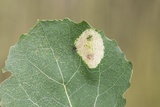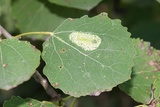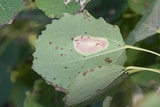Phyllonorycter sagitella (Bjerkander, 1790) Species
Last modified: Sept. 2, 2025, 5:47 p.m.
A widespread but local and fairly common species in Belgium.
Details
- Classification
- Family: Gracillariidae > Subfamily: Lithocolletinae > Genus: Phyllonorycter > Species: Phyllonorycter sagitella
- Vernacular names
- Rode espenvouwmot (NL), Scarce aspen midget (EN), Espen-Faltenminiermotte (DE)
- Synonyms
- Phyllonorycter tremulae (Zeller, 1846)
- First mention in Belgium
- De Crombrugghe G. 1905. Note sur quelques Microlépidoptères de la faune belge. — Annales de la Société Entomologique de Belgique 49: 100–107. On page 107 (as Lithocolletis tremulae Z.). view page
- Status
-
Native
Distribution
Imago
Head brown, mixed with many white hairs; forewing ground colour ochreous brown with indistinct white pattern consisting of four costal and three dorsal striae, all ill-defined; the entire wing is covered with scattered brown-tipped scales.
Museum specimens
No pictures yet!Specimens in nature
No pictures yet!Mine
A semi-circular or oval tentiform mine on the underside of a leaf. At first, the mine has a yellowish tinge, sometimes with a pink, or even reddish, hue, but after a while, it colours dark brown till even blackish. The underside is flat, without any longitudinal folds. The black frass is concentrated in a corner of the mine.
See also gracillariidae.net and bladmineerders.be.
Cocoon/pupa
A flimsy cocoon in the opposite corner than the one where the frass is stored. Pupal skin very dark brown or black.
Bionomics
The species hibernates in the pupal stage. After emergence of the adult, the pupal skin protrudes through the mine.
Flight periods
Two generations a year in April–May and August–September.
Observed on
- Host plant (species):
- Populus tremula
The species is monophagous on Populus tremula, especially the saplings.




